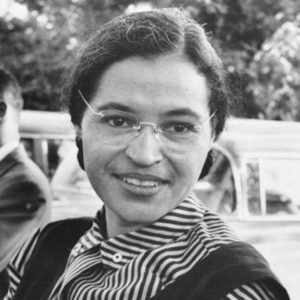
Rosa Parks
On the evening of 1st December 1955, 42-year-old Rosa Parks was sitting in the front seat of a bus in Montgomery, Alabama, US. Those days, there was segregation in buses with the whites sitting in the front and the blacks in the back. Rosa was in the first row of the black section. The white people were sitting in the white section.
Soon, more white people got on, and they filled up all the seats in the white section. Whenever that happened, the blacks were supposed to give up their seats to the whites. On that day, however, Rosa didn’t move. The white driver said, “Let me have those front seats.” Rosa didn’t get up. She was tired of giving in to white people.
“I’m going to have you arrested,” the driver said. “You may do that,” Rosa answered.” The driver called the police. Two white policemen came into the bus. Rosa asked one of them, “Why do you all push us around?” He answered, “I don’t know, but the law is the law and you’re under arrest.” Rosa Parks was put in a jail and she could come out the next day after her husband Raymond arranged for the bail amount. The trial was to be conducted on December 5.
Rosa and her husband Raymond were activists with the National Association for the Advancement of Colored People (NAACP) and had been helping many blacks with court cases, voter registration, and so on. In the southern states such as Alabama racism was rampant at that time. Blacks were denied basic civil rights and oppressed in various ways. Even before the Rosa case, black women had been arrested for protesting against segregation in buses.
Following Rosa’s arrest, the black leaders called on the community to boycott the bus service on 5th December, the day of the Rosa Parks trial. The blacks, tired of being pushed around for so long, responded to the call in large numbers. The boycott was led by the newly-formed Montgomery Improvement Association. Its President was the young pastor, Dr. Martin Luther King, Jr., who was to become the leader of the Civil Rights Movement.
On the evening of 5th December, at a meeting in which Rosa Parks was a prime participant, the MIA decided to continue the boycott indefinitely. They also placed three demands before the bus company and the city’s white leaders: 1) Courteous treatment on the buses; 2) First-come, first-served seating, with whites in front and blacks in back; 3) Hiring of black drivers for the black bus routes.
Days, then months, passed and the bus boycott continued. Very few blacks took the buses. Some walked to their places of work, others got rides with black-owned cabs. Many white women came in their cars to pick up their black maids. Volunteers distributed to the people clothes and shoes received from all parts of the country. Rosa Parks travelled to several cities to give talks and collect funds. Since the buses had been used mostly by the blacks, they now ran nearly empty.
The police began to harass the blacks in various ways and many blacks lost their jobs. But the boycott went on. The bus company and downtown businesses suffered losses. Meanwhile, the case against segregation filed by the black groups reached the Supreme Court. Finally, in November 1956, the Supreme Court ruled that segregation on Montgomery buses was unconstitutional.
The bus boycott was ended only on December 20, 1956, after receiving the written orders of the Supreme Court. The yearlong saga came to a successful end, but the struggle for civil rights continued for many more years under the leadership of Dr. King. Rosa Parks was an active participant in the movement. Finally, President Lyndon Johnson pushed through in 1964 the Civil Rights Act. That was a major victory, though the discrimination of blacks continues until today.
In her autobiography, Rosa Parks says, “I had no idea when I refused to give up my seat on that Montgomery bus that my small action would help put an end to the segregation laws in the South. I only knew that I was tired of being pushed around. I was a regular person, just as good as anybody else.”
Rosa Parks continued to work for the cause of civil rights in spite of health issues and poor finances. She died on October 24, 2005, in Detroit, Michigan.
Afterword: This story is mostly based on the book My Story, the autobiography of Rosa Parks. A number of books and videos on Rosa Parks are available on the web.

What was the spark that erupted into a fire as time passed by? It was her courage and conviction, that was initially not recognised by Rosa Parks herself. But as time went by, she was more adamant to fight for her rights and to fight for a cause of the black population. It also turned out that the blacks supported her in her cause as it was their cause as well. This is an example where things done with utmost belief and sincerity will have support from different quarters, converting a gale into a tornado. It may sometimes cause personal struggle and strife in the life of the individual, but, the outcomes from such struggles are far more satisfying. It often becomes a habit or a passion to attend to accepted tasks in spite of personal losses and strife. Such is the strength of conviction in human lives and Rosa Parks’ endeavour is one such example.